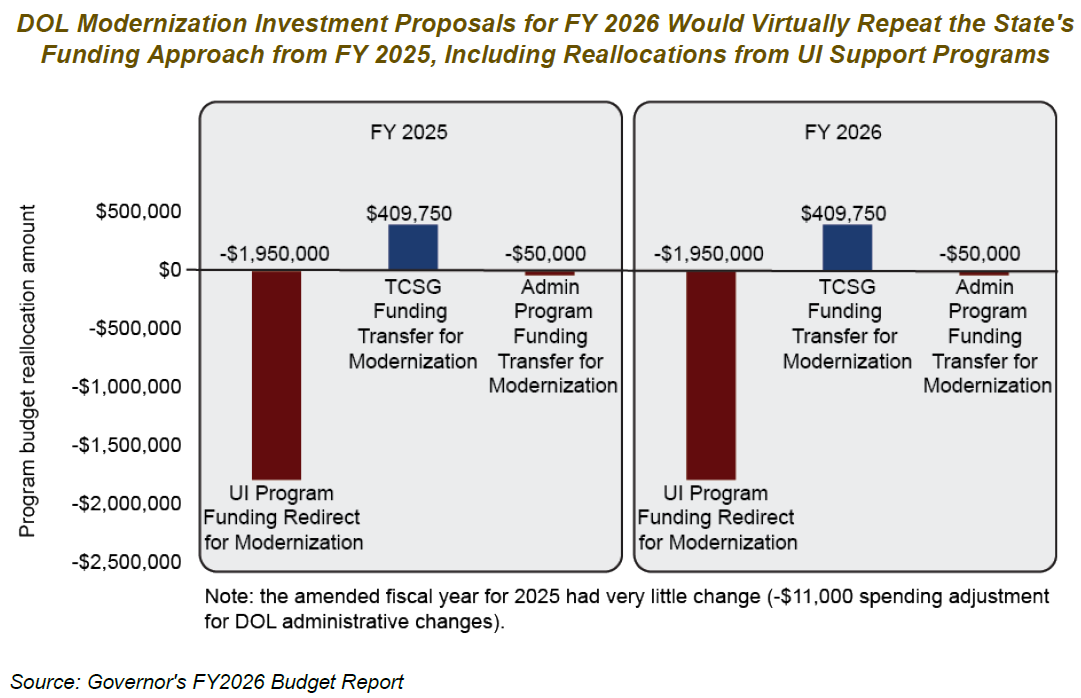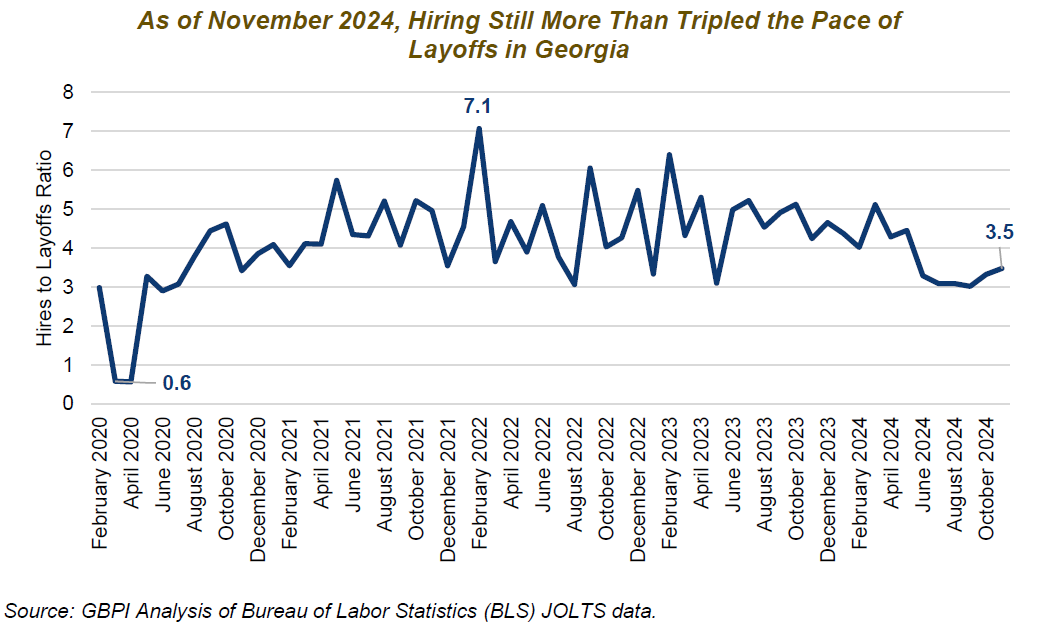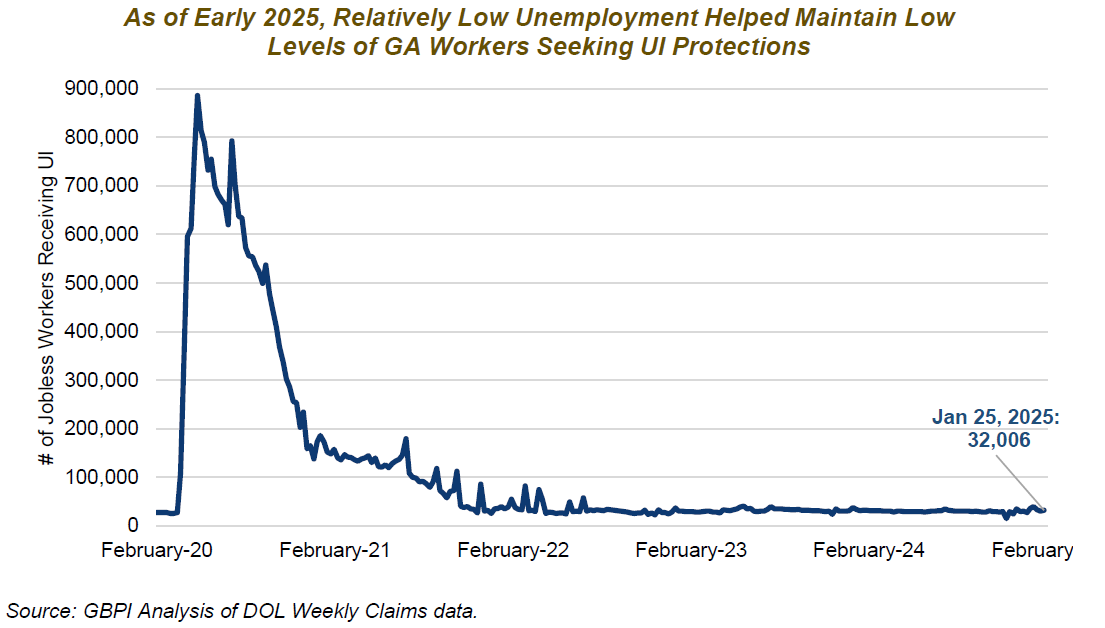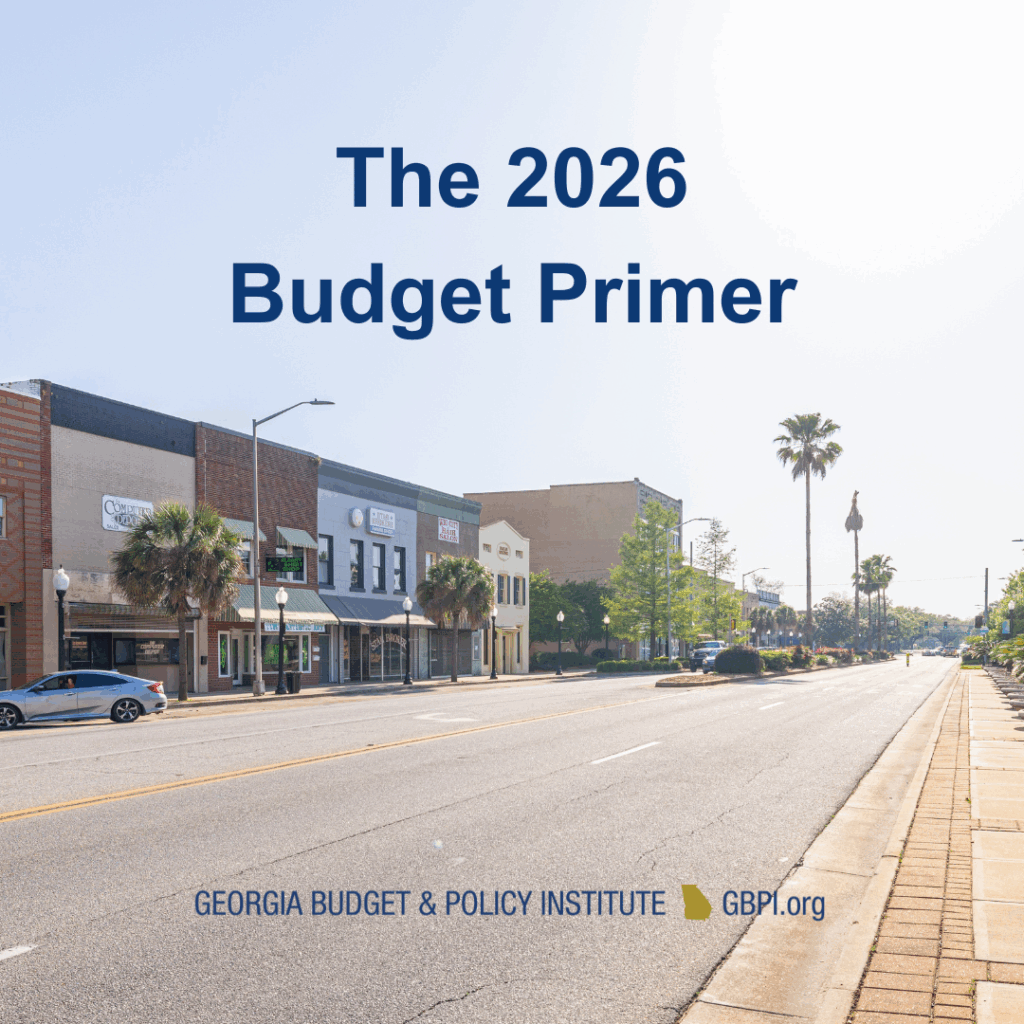The Georgia Department of Labor (DOL) is an agency tasked with maintaining a resilient Unemployment Insurance (UI) system to protect workers who lose jobs at no fault of their own during their transition back into the workforce. This resilience provides economic stability during recessions. DOL is also tasked with generating revenue through contributions that it receives from employers, which helps fund its administrative operations and UI benefit trust fund.
Governor Kemp’s proposed budget for the amended fiscal year (AFY) 2025 provided no net changes for DOL. Following proposals for no added investments to complete the current fiscal year 2025, proposals for fiscal year 2026 include spending reductions of $11,000 to compensate for minor administrative adjustments within the agency.[1] At large, these spending proposals are a continuance of spending levels from the prior fiscal year, which included state fiscal adjustments to supplement federal investments to help initiate a process of modernizing DOL’s unemployment insurance (UI) system. This process included migrating UI application files to a digital cloud environment, addressing UI appeal hearing case backlogs and managing customer service challenges, and is meant to continue with the support of these latest state funding proposals.

By The Numbers
Proposed Amended FY 2025 Highlights
- No changes
Proposed FY 2026 Highlights
- $8 thousand in reduced spending for adjustments to insurance premiums that cover the Department of Labor
- $3 thousand in reduced spending to account for administrative adjustments to meet projected expenditures within the agency
State Investments in DOL Modernization Are Minimal in Comparison with Agency-Generated Revenue
Like all state systems, the modernization of Georgia’s UI system is an ongoing process of adapting systems and programs to meet workers’ evolving needs, new federal UI programs and changing tactics of fraudulent criminal networks. These ongoing adaptations require sustained investment, including state funding to support the fluctuation of federal dollars. Federal relief funding from the American Rescue Plan provided $11.3 million in FY 2024 to support cloud technology to make Georgia’s UI system more flexible and more user friendly.[2] In the same fiscal year, Georgia DOL received $3.1 million in federal funds to make language more accessible and user friendly in its UI benefit applications.[3] According to DOL testimony in 2024, state-level modernization investments were insufficient to adequately support DOL’s modernization needs.[4]
As the agency is tasked with several critical roles to help support a thriving state, yearly state funding allocations have recently been millions of dollars below the requests of agency leaders. The latest fiscal disconnect between agency leaders and state lawmakers is sizable. The budget that supported DOL modernization projects into Fiscal year 2025 was $8.5 million.[5] That amount was nearly $10 million below DOL leaders’ requests and only $443,000 above the prior year’s state spending levels.[6]
Governor Kemp’s latest modernization-related proposals reflect a continued approach of relying on taking a significant portion, $2 million in FY 2026, away from DOL programs that have otherwise been available to support UI benefit administration and UI Trust Fund revenue collection.
Broader Budget Implications
DOL has continued performing unprecedented agency modernizations while workers have sought lost wage protections from DOL at relatively low levels following the post-COVID economic recovery. As of November 2024, statewide hiring still outpaced layoffs, helping to maintain relatively low unemployment rates and UI claim levels. This provides an opportune period for the state to modernize DOL, replenish its Unemployment Insurance (UI) Trust Fund reserves and prepare in case of a future recession.


Despite the current period of relatively low overall unemployment, Black workers in Georgia continue to face an outsized share of job displacement. As of third quarter 2024, their unemployment rate (5.7%) was significantly higher than the state average (3.5%) and more than doubled that of white workers (2.2%). By the end of 2024 their overrepresentation in UI benefit enrollment, 62% of all enrollees,[7] still nearly doubled their 33% share of the workforce.[8]
As modernization investments continue, Georgia’s latest UI system performance demonstrates that it remains unprepared to handle recession-level demands. By the end of 2024, 74% of Georgia workers’ UI claims were processed for first payment within 21 days,[9] which remain significantly below the 87% federal standard.[10] However, investments to streamline DOL claim processing and expand public access to UI benefits are incomplete without measures to strengthen contributions to Georgia’s UI Trust Fund reserves, which supply the benefits that protect displaced workers. As of early January 2025, its UI Trust Fund reserve held $1.8 billion, which is far below the federally recommended level of $3.2 billion and only slightly higher than its $1.6 billion level in early Jan 2024.[11] For context, when its reserve held $1.6 billion, Georgia could only offer displaced worker protections for roughly 5 months of an average recession. This is attributed to Georgia having one of the nation’s lowest average Trust Fund contribution rates.[12]
As lawmakers consider state spending proposals to support agency modernization efforts during a non-recession opportunity window, displaced workers and the economy alike can benefit from system upgrades that improve access while balancing needs for maintaining adaptable security measures. UI payment integrity data trends demonstrate the need for a modernized system which is not over-calibrated in ways that create false UI fraud accusations or deter displaced workers from seeking lost wage protection. By FY 2024, the fraudulent share of UI benefit payments declined to only 0.8% of UI benefit payouts.[13]
Endnotes
[1] Fiscal Year 2026 Governor’s Budget Report, from https://opb.georgia.gov/budget-information/budget-documents/governors-budget-reports.
[2] US Department of Labor. (2023, September 22). US Department of Labor announces $204M in grants to improve capacity, user experience, reliability of unemployment insurance systems. https://www.dol.gov/newsroom/releases/eta/eta20230922
[3] US Department of Labor. (2023, August 31). US Department of Labor awards $3M in funding to promote equitable access to unemployment benefits in Georgia. https://www.dol.gov/newsroom/releases/eta/eta20230831-0
[4] GA DOL testimony in Joint Committee on Appropriations. (2024, January 17). https://vimeo.com/showcase/9603707?video=903777522
[5] Ibid.
[6] January 17, 2024 testimony from former Georgia Department of Labor Commissioner Bruce Thompson, and current Chief Financial Officer Kate Furman, in a Joint Appropriations Committee Hearing in the Georgia General Assembly. From https://vimeo.com/showcase/9603707?video=903777522.
[7] GBPI analysis of Employment Training Administration (ETA) 203 reports within the Department of Labor.
[8] Economic Policy Institute, State of Working America Data Library, “Share of labor force participation – labor force participants, 12-month average”.
[9] GBPI analysis of DOL Payment and Timeliness Quality Reports, from https://oui.doleta.gov/unemploy/btq.asp
[10] DOL unemployment insurance data dashboard, from https://oui.doleta.gov/unemploy/pdf/Core_Measures.pdf
[11] Unemployment trust fund report from Treasury Direct, from https:// www.treasurydirect.gov/govt/reports/tbp/account-statement/report.html
[12] US Department of Labor. Average Employer Contribution Rates by State. Retrieved 2/13/2025, from https://oui.doleta.gov/unemploy/avg_employ.asp
[13] DOL ETA unemployment insurance accuracy data reports, from https://www.dol.gov/agencies/eta/unemployment-insurance-payment-accuracy/data.









